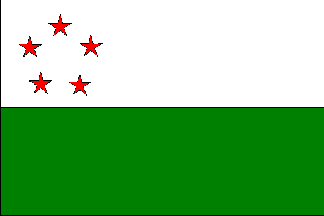 klaus-michael schneider
klaus-michael schneider
Keywords: guayas | milagro |
Links: FOTW homepage | search | disclaimer and copyright | write us | mirrors

Last modified: 2021-08-26 by  klaus-michael schneider
klaus-michael schneider
Keywords: guayas | milagro |
Links: FOTW homepage |
search |
disclaimer and copyright |
write us |
mirrors
 image by Falko Schmidt, 16 June 2001
image by Falko Schmidt, 16 June 2001
See also:
The municipality of San Francisco de Milagro (usually known as Milagro;
154,279 inhabitants; 40,810 ha) is located 50 km east of Guayaquil.
Milagro is named after a miracle ("milagro") dated 1786. The local legend says
that María de Salcedo, wife of the landlord Miguel de Salcedo, sick of malaria,
initiated a "novena" (a prayer repeated for nine successive days or even weeks),
asking the intercession of St. Francis of Assisi to heal her. In the aftermath
of his wife's complete recovery, Miguel de Salcedo requested on 15 December 1786
from the governor of Guayaquil the authorization to establish a new settlement
named San Francisco de Milagro. No answer was obtained but the proposed name
remained.
The parish of Milagro was established on 17 October 1842, as part of Guayaquil
canton. Transferred on 21 July 1883 to the newly established Yaguachi canton,
Milagro was elevated to a canton on 17 September 1913.
Source: Historia y Cultura del
Cantón San Francisco de Milagro
Ivan Sache, 14 July 2018
On the website <www.cpg.gov.ec/milagro.htm>
(defunct), the stars on the flag are red and not like reported formerly as white. Canton established 17
September 1913.
Falko Schmidt, 16 June 2001
On the Guayas site <www.cpg.gov.ec>
(defunct) the Milagro flag bears 5 white stars in the shape of a
circle on the upper hoist (that is, white stars on white field...
the white stars are outlined in black).
Dirk Schonberger, 18 January 2001
Same image of the flag at <www.guayas.gov.ec>.
Silver stars on white! This does'nt have any logic. I suspect
that the stars are red.
Falko Schmidt and Jens Pattke, 8 and 9
September 2003
The flag of Milagro is prescribed by an Ordinance issued on 27 August 1960 by
the Cantonal Council.
The flag of the canton shall have the same dimensions as the national flag and
the following colors: white and green in equal, horizontal stripes, with a
circle of five red stars in the upper corner of the white stripe, close to the
hoist.
White represents the purity and virtuosity of the women of Milagro.
Green represents the agricultural significance of Milagro, which produces rice,
coffee, cocoa, pineapples and sugarcane in fields where the green colors
predominates.
Source:
Historia y Cultura del Cantón San Francisco de Milagro
Photo:
http://vozdemilagro.blogspot.fr/2014/08/alcaldesa-de-milagro-entregara-terrenos.html
For whatever reason, the flag in official use is different from the prescribed
flag, being horizontally divided white-green with the municipal coat of arms.
Photo:
http://www.milagro.gob.ec/gobierno/la-alcaldesa/
Ivan Sache, 14 July 2018
g-mil.jpg) image from
www.guayas.gov.ec,
located by Jens Pattke, 8 September 2003
image from
www.guayas.gov.ec,
located by Jens Pattke, 8 September 2003
The coat of arms of Milagro is prescribed by an Ordinance issued on 9 April
1965 by the Cantonal Council.
Quarterly, 1. Argent a sugarcane vert, 2. Azure a native axe or like those used
in the Chirijo region, 3. Azure a cog wheel or, 4. Argent a rice panicle or. A
bordure gules eight pineapples or. The shield surmounted by five five-pointed
stars argent. Beneath the shield a scroll per fess argent and vert inscribed
with "San Francisco de Milagro" and the the years "1786" and "1913",
respectively.
The arms, selected in a public contest organized in August 1964 by the Municipal
Council, were designed by Rodolfo Pérez Pimentel, an historian and heraldist
from Guayaquil, and drawn by Jorge Swett Palomeque.
The cog wheel and the sugarcane recall Ingenio Valdez, the company established
in 1884 in Milagro by Rafael Valdez, credited today of 30% of the sugar
production in Ecuador.
The bordure gules recalls the blood shed during the liberal revolution initiated
in 1895.
On 10 August 1964, Pérez Pimentel came back to Ecuador from a one-year stay in
the US. In early September, his friend Vicente Muñoz Elizalde informed him that
the President of the Municipal Council was interested in commissioning him to
design the municipal arms. The heraldist visited his master, Pedro Robles y
Chambers, who suggested a modern, quartered shield and helped him to design it.
The next day, Pérez and Muñoz presented the design to the Municipal Councillors,
who enjoyed it as a synthetic representation of the history and present of
Milagro.
Pérez' sole competitor, the local painter Jorge Swett Palomeque, proposed a
multicolored shield featuring a woman wearing a cap and clad with a Roman tunic,
holding a cornucopia full of all kinds of fruit, all the elements being arranged
in a very confuse manner. The painter challenged Pérez' design, arguing that
heraldry, "a kings' science", should not be "imposed to a republic", and that
modern human activities could not be represented in compliance with the rules of
classic heraldry.
The Council eventually decided to adopt Pérez' design and to commission Swett to
draw the official version of the arms.
Source:
Historia y Cultura del Cantón San Francisco de Milagro
The coat of arms used on the flag is faithful to the original design, except the
stars that are colored red.
Rodolfo Pérez Pimentel (b. 1939) is a noted Ecuadorian historian and biographer,
author of a famous "Diccionario biográfico del Ecuador". Member of the National
Academy of History, he was appointed one of the four Permanent Chroniclers of
the town of Guayaquil in 2011.
Sources:
El Telégrapho, 3 July 2011 and
Diccionario
biográfico del Ecuador
Jorge Swett Palomeque (1926-2012) was mostly known as a muralist, who designed
morn than 120 murals in different places of the Guayaquil.
Source:
El Comercio, 25 February 2012
Ivan Sache, 14 July 2018